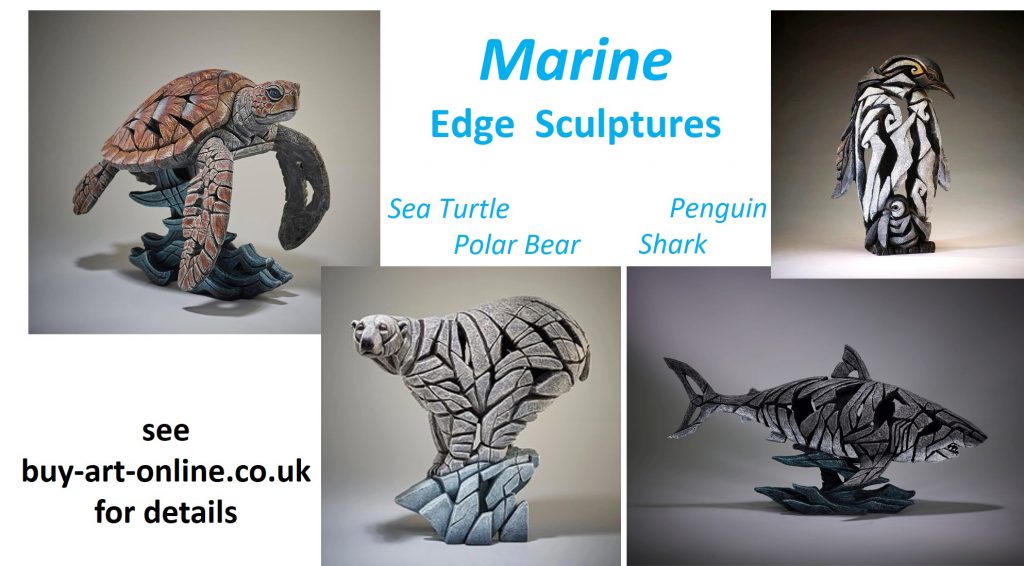Acrylic ladies on real pebbles from the local beach. A stunning pair of original paintings from Artist in Residence, Susi Whittaker

Framed in White to 30 x 40 cm overall | £ 195 each | Buy Now
Acrylic ladies on real pebbles from the local beach. A stunning pair of original paintings from Artist in Residence, Susi Whittaker

Framed in White to 30 x 40 cm overall | £ 195 each | Buy Now
Coming soon to a gallery not so far far away ! A classic example of the art of the unique artist JJ Adams featuring caracters from the iconic film, Star Wars.
Move Along by JJ Adams
Limited Edition Print of 95
Framed in Black or White to 90 x 105 cm
Price : £ 540 inc free delivery | Buy Now

There are a wide range of bright and vibrant bronze octopuses also available as limited edition sculptures which are produced in the same way as the bronze frogs in the Frogman foundry. They are designed by Hawaiian Marine artist Chris Barela.
See the Sculptures of Chris Barela


A collection of signed photographic prints taken from around the world are now available to buy online with free delivery ! Taken by Chris Whittaker of Global Shenanigans they feature wildlife, adventure and sports.
See the Art of Chris Whittaker

Budge Up ! is an original painting especially for Dachshund and Budgerigar lovers !! It is a humorous depiction of colourful budgerigars getting a free ride on the back of an adorable dachshund. This unique art work was created by our Artist in Residence, Susi Whittaker, whose fun and creative work is well known to her many followers.
Budge Up !
Original Painting, Acrylic on Canvas
Framed in Grey to 67 x 36 cm overall
Price £450 | Buy Now

The Countryside range of wildlife sculptures, created by Matt Buckley of Edge Sculpture, includes popular British animals of Hares, Foxes and Squirrels.

A series of humorous limited editions from Dale Bowen with a distinctly colourful sheep-ish theme ! All have 3D elements within the pictures which are covered in a high gloss resin to stunning effect.

Thursday ! An original painting from our Artist In Residence, Susi Whittaker, in recognition of the Clap For Carers initiative and support of the NHS, care and key workers everywhere. A 10% donation to NHS Charities Together will also be made from the purchase.
NHS Charities Together marvellous work funds major capital projects, pioneers research and medical equipment at our hospitals. Read More About NHS Charities Together,
Thursday
Original Painting Framed in Grey to 60 x 30 cm overall
Cost £ 450 incl free delivery Buy Now

Morning Light … a fabulous original oil on board, framed in silver to 109 x 109 cm overall by Alex Jawdokimov.
See Morning Light by Alex Jawdokimov

The Marine related sculptures by Matt Buckley of Edge Sculpture currently includes a Shark, Penguin, Polar Bear and a Sea Turtle.
Penguin | Polar Bear | Sea Turtle | Shark

Penguins are a group of aquatic flightless birds. They live almost exclusively in the Southern Hemisphere with only one species found north of the equator. Highly adapted for life in the water, penguins have dark and white plumage and flippers for swimming. Most penguins feed on krill, fish, squid and other forms of sea life which they catch while swimming underwater. They spend roughly half of their lives on land and the other half in the sea.
Polar Bears native range is within the Arctic Circle, encompassing the Arctic Ocean, its surrounding seas and surrounding land masses. It is a large bear with the adult male weighing around 350–700 kg while the adult female is about half that size. Polar bears are the largest land carnivores currently in existence with many body characteristics adapted for cold temperatures, for moving across snow, ice and open water, and for hunting seals, which make up most of its diet.Although most polar bears are born on land, they spend most of their time on the sea ice. The Polar bear hunts their preferred food of seals from the edge of sea ice, often living off fat reserves when no sea ice is present. Because of their dependence on the sea ice, polar bears are classified as marine mammals.
The Sea Turtle has a more spindle shaped body, ie tapering at both ends, than its terrestrial counterparts with both females and males being of the same size. This tapering at both ends reduces volume and means that sea turtles can’t, as can other turtles and tortoises, retract their head and limbs into their shells for protection. The streamlined body however does reduce friction and drag in the water and allows sea turtles to swim more easily and swiftly. The leatherback sea turtle is the largest sea turtle, measuring 2–3 meters (6–9 ft) in length, and 1-1.5 m (3–5 ft) in width, weighing up to 700 kilograms (1500 lb).
Sharks are a group of fish characterized by a cartilaginous skeleton, five to seven gill slits on the sides of the head, and pectoral fins that are not fused to the head. The earliest known shark dates back to more than 420 million years ago.They range in size from the small dwarf lanternshark, a deep sea species of only 17 centimetres (6.7 in) in length, to thw whale shark, the largest fish in the world, which reaches approximately 12 metres (40 ft) in length. Sharks are found in all seas and are common to depths of 2,000 metres (6,600 ft).